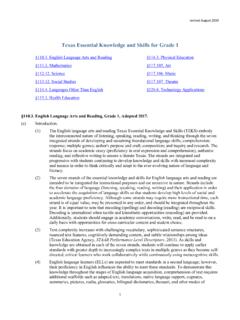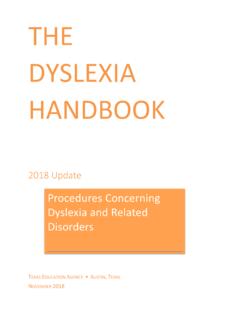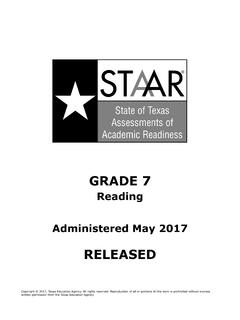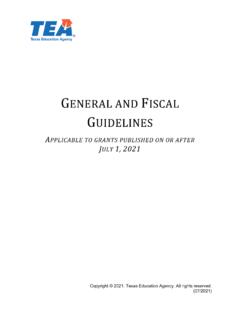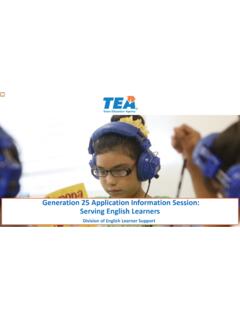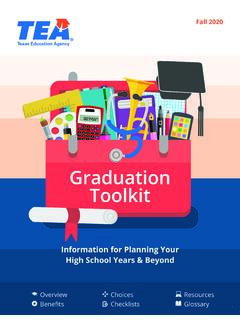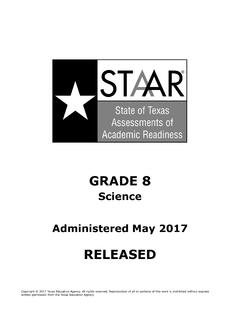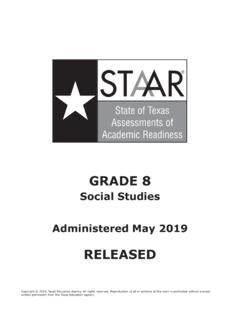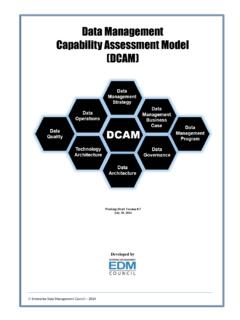Transcription of Chapter 111. Texas Essential Knowledge and Skills for ...
1 Elementary Chapter 111. Texas Essential Knowledge and Skills for Mathematics Subchapter A. Elementary Statutory Authority: The provisions of this Subchapter A issued under the Texas Education Code, (c)(4), , and (a)(1), unless otherwise noted. Implementation of Texas Essential Knowledge and Skills for Mathematics, Elementary, Adopted 2012. (a) The provisions of of this subchapter shall be implemented by school districts. (b) No later than August 31, 2013, the commissioner of education shall determine whether instructional materials funding has been made available to Texas public schools for materials that cover the Essential Knowledge and Skills for mathematics as adopted in of this subchapter. (c) If the commissioner makes the determination that instructional materials funding has been made available under subsection (b) of this section, of this subchapter shall be implemented beginning with the 2014-2015 school year and apply to the 2014-2015 and subsequent school years.
2 (d) If the commissioner does not make the determination that instructional materials funding has been made available under subsection (b) of this section, the commissioner shall determine no later than August 31 of each subsequent school year whether instructional materials funding has been made available. If the commissioner determines that instructional materials funding has been made available, the commissioner shall notify the State Board of Education and school districts that of this subchapter shall be implemented for the following school year. Source: The provisions of this adopted to be effective September 10, 2012, 37 TexReg 7109; amended to be effective December 31, 2014, 39 TexReg 10470. Kindergarten, Adopted 2012. (a) Introduction. (1) The desire to achieve educational excellence is the driving force behind the Texas Essential Knowledge and Skills for mathematics, guided by the college and career readiness standards.
3 By embedding statistics, probability, and finance, while focusing on computational thinking, mathematical fluency, and solid understanding, Texas will lead the way in mathematics education and prepare all Texas students for the challenges they will face in the 21st century. (2) The process standards describe ways in which students are expected to engage in the content. The placement of the process standards at the beginning of the Knowledge and Skills listed for each grade and course is intentional. The process standards weave the other Knowledge and Skills together so that students may be successful problem solvers and use mathematics efficiently and effectively in daily life. The process standards are integrated at every grade level and course. When possible, students will apply mathematics to problems arising in everyday life, society, and the workplace.
4 Students will use a problem-solving model that incorporates analyzing given information, formulating a plan or strategy, determining a solution, justifying the solution, and evaluating the problem-solving process and the reasonableness of the solution. Students will select appropriate tools such as real objects, manipulatives, algorithms, paper and pencil, and technology and techniques such as mental math, estimation, number sense, and generalization and abstraction to solve problems. Students will effectively communicate mathematical ideas, reasoning, and their implications using multiple representations such as symbols, diagrams, graphs, computer programs, and language. Students will use mathematical relationships to generate solutions and make connections and predictions.
5 Students will analyze mathematical relationships to connect and communicate mathematical ideas. Students will display, explain, or justify mathematical ideas and arguments using precise mathematical language in written or oral communication. December 2014 Update Page 1. Elementary (3) For students to become fluent in mathematics, students must develop a robust sense of number. The National Research Council's report, "Adding It Up," defines procedural fluency as "skill in carrying out procedures flexibly, accurately, efficiently, and appropriately." As students develop procedural fluency, they must also realize that true problem solving may take time, effort, and perseverance. Students in Kindergarten are expected to perform their work without the use of calculators.
6 (4) The primary focal areas in Kindergarten are understanding counting and cardinality, understanding addition as joining and subtraction as separating, and comparing objects by measurable attributes. (A) Students develop number and operations through several fundamental concepts. Students know number names and the counting sequence. Counting and cardinality lay a solid foundation for number. Students apply the principles of counting to make the connection between numbers and quantities. (B) Students use meanings of numbers to create strategies for solving problems and responding to practical situations involving addition and subtraction. (C) Students identify characteristics of objects that can be measured and directly compare objects according to these measurable attributes.
7 (5) Statements that contain the word "including" reference content that must be mastered, while those containing the phrase "such as" are intended as possible illustrative examples. (b) Knowledge and Skills . (1) Mathematical process standards. The student uses mathematical processes to acquire and demonstrate mathematical understanding. The student is expected to: (A) apply mathematics to problems arising in everyday life, society, and the workplace;. (B) use a problem-solving model that incorporates analyzing given information, formulating a plan or strategy, determining a solution, justifying the solution, and evaluating the problem-solving process and the reasonableness of the solution;. (C) select tools, including real objects, manipulatives, paper and pencil, and technology as appropriate, and techniques, including mental math, estimation, and number sense as appropriate, to solve problems.
8 (D) communicate mathematical ideas, reasoning, and their implications using multiple representations, including symbols, diagrams, graphs, and language as appropriate;. (E) create and use representations to organize, record, and communicate mathematical ideas;. (F) analyze mathematical relationships to connect and communicate mathematical ideas; and (G) display, explain, and justify mathematical ideas and arguments using precise mathematical language in written or oral communication. (2) Number and operations. The student applies mathematical process standards to understand how to represent and compare whole numbers, the relative position and magnitude of whole numbers, and relationships within the numeration system. The student is expected to: (A) count forward and backward to at least 20 with and without objects.
9 (B) read, write, and represent whole numbers from 0 to at least 20 with and without objects or pictures;. (C) count a set of objects up to at least 20 and demonstrate that the last number said tells the number of objects in the set regardless of their arrangement or order;. (D) recognize instantly the quantity of a small group of objects in organized and random arrangements;. Page 2 December 2014 Update Elementary (E) generate a set using concrete and pictorial models that represents a number that is more than, less than, and equal to a given number up to 20;. (F) generate a number that is one more than or one less than another number up to at least 20;. (G) compare sets of objects up to at least 20 in each set using comparative language;. (H) use comparative language to describe two numbers up to 20 presented as written numerals; and (I) compose and decompose numbers up to 10 with objects and pictures.
10 (3) Number and operations. The student applies mathematical process standards to develop an understanding of addition and subtraction situations in order to solve problems. The student is expected to: (A) model the action of joining to represent addition and the action of separating to represent subtraction;. (B) solve word problems using objects and drawings to find sums up to 10 and differences within 10; and (C) explain the strategies used to solve problems involving adding and subtracting within 10. using spoken words, concrete and pictorial models, and number sentences. (4) Number and operations. The student applies mathematical process standards to identify coins in order to recognize the need for monetary transactions. The student is expected to identify coins by name, including pennies, nickels, dimes, and quarters.
